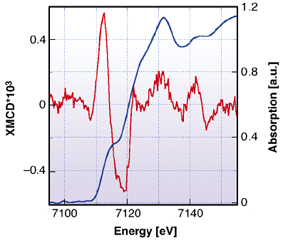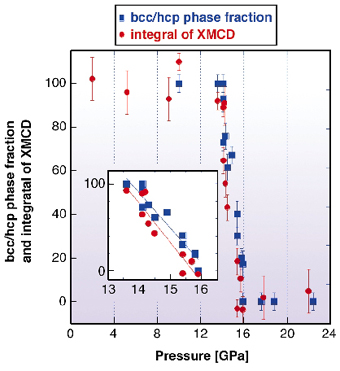- Home
- Users & Science
- Scientific Documentation
- ESRF Highlights
- ESRF Highlights 2004
- X-ray Absorption and Magnetic Scattering
- Simultaneous Magnetic and Structural Study of the Iron ALPHA-EPSILON Pressure Phase Transition
Simultaneous Magnetic and Structural Study of the Iron ALPHA-EPSILON Pressure Phase Transition
The iron phase-diagram has attracted considerable interest for many years now. At the beginning, the motivation was to discover its central role in the behaviour of alloys and steel. Later its geophysical importance was underlined, because of its predominant abundance in the Earth's core. The phase diagram of iron under extreme pressure and temperature conditions is still far from being established. Under application of an external pressure, iron undergoes a transition at 13 GPa from the bcc ![]() -phase to the hcp
-phase to the hcp ![]() -phase structure, with the loss of its ferromagnetic long range order.
-phase structure, with the loss of its ferromagnetic long range order.
We have performed a simultaneous X-ray absorption spectroscopy (XAS) and X-ray magnetic circular dichroism (XMCD) study of the Fe bcc-hcp phase transition with pressure. In absorption spectroscopy, polarised X-rays are intrinsic structural, electronic and magnetic probes. Methods used are extended X-ray absorption fine structure (EXAFS), X-ray absorption near edge structure (XANES) and XMCD. The XAS techniques are able to clearly differentiate the signature of bcc or hcp local symmetry, while XMCD is very sensitive to changes in the magnetic moments. Thus, for each pressure point, we can obtain simultaneous information on both the magnetic and structural properties of the system, i.e. on the same sample and under the same thermodynamic conditions. Consequently, there is no relative pressure incertitude for each measurement. This is very important in the high-pressure domain where reproducibility of the hydrostatic conditions is difficult to obtain. As an example, Figure 111 presents the K-edge XANES and XMCD signals of a pure Fe foil recorded at 10 GPa.
 |
Fig. 111: K-edge XANES and XMCD signals of pure Fe foil recorded at 10 GPa. |
The experiment was carried out at ID24, the ESRF's dispersive XAS beamline. Parallel detection of the whole spectrum is made possible by the energy-dispersive highly-focusing X-ray optics. The beamline is particularly well-suited for combined high pressure and XAS-XMCD studies at the Fe-K edge using a diamond anvil cell.
Figure 112 presents the evolution of the bcc/hcp phase fraction (full squares) and the magnetic/non-magnetic phase fraction (full circles) as a function of pressure. The onset of the structural transition occurs at about 13.8 GPa and is over at 16.2 GPa. The magnetic transition is indeed quite abrupt occurring within a pressure range of 2.2 GPa, with an onset at 13.5 GPa. Our data shows that between 13.5 and 15.7 GPa, the XMCD is suddenly reduced to zero, within the error bars, indicating the disappearance of the room temperature ferromagnetic order of iron. The abrupt drop to zero of the iron magnetic moment when the bcc to hcp phase transition occurs proves the first order nature of the pressure-induced magnetic transition. The pressure transition domain for both the structural and the magnetic phase transition is narrower with respect to previous structural and magnetic studies. It could be attributed to a lower pressure gradient within the probed region and directly correlated to the smaller sample volume probed.
 |
Fig. 112: Evolution of the amplitude of the XAS (full squares) and of the XMCD signals (full circles) with pressure. |
A closer look at the data obtained shows that the value of the magnetic/non-magnetic phase fraction is systematically lower than that of the bcc/hcp phase fraction for each XAS/XMCD pair of measurements during the phase transition. Thanks to the combination of the two probes, there is no relative pressure incertitude between the XAS/XMCD data points. Therefore, our study suggests that the iron high spin ferromagnetic state disappears before complete transformation into hcp. This is better seen on the enlargement of the transition region in Figure 112. Our observations are in good agreement with the theoretical transition scheme given by Ekman et al. [2]. This could also be due to the presence of magnetically dead layers at the interface between the bcc and hcp phase.
In summary, we have measured XAS and XMCD of iron metal under pressure along the bcc to hcp phase transition. The simultaneous measurement of element specific magnetic properties using XMCD and of element specific local structural and electronic properties using XAS has an enormous potential in correlating the magnetic, electronic and structural degrees of freedom during phase transitions. For Fe at high pressure, we find that the local structure and the magnetic transition occur within 2.4 GPa and are much sharper than usually described in the literature. This proves unambiguously the first order nature of the iron bcc to hcp transition. We have also evidence of a small pressure gap between the magnetic transition and the structural one, suggesting the driving role of magnetism during the transition.
References
[1] O. Mathon, F. Baudelet, J.-P. Itié, S. Pasternak, A. Polian, S. Pascarelli, J. Sync. Rad., 11, 423-427 (2004).
[2] M. Ekman, B. Sadigh, K. Einarsdotter and P. Blaha, Phys. Rev. B 58, 5296 (1998).
Principal Publication and Authors
O. Mathon (a), F. Baudelet (b, c), J.-P. Itié (b), A. Polian (b), M. d'Astuto (b), J.-C. Chervin (b), S. Pascarelli (a), Phys. Rev. Lett., 93, 255503 (2004).
(a) ESRF
(b) Physique des Milieux Condensés (UMR 7602), Université Pierre et Marie Curie, Paris (France)
(c) Synchrotron SOLEIL, Gif-sur-Yvette (France)



